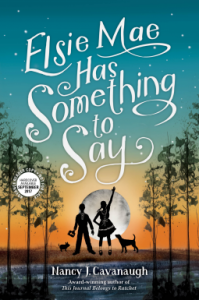
Nancy Cavanaugh
Sourcebooks Jabberwocky
Published on September 5, 2017

Amazon | Barnes & Noble | Goodreads
About Elsie Mae Has Something to Say
Elsie Mae is determined to save her beloved Okefenokee Swamp, but is she willing to accept the unexpected?
Elsie Mae has long treasured summers with her grandparents in the Okefenokee Swamp, so she is devastated to hear that a shipping company plans to build a canal right through it. What will that mean for the people and animals that call the swamp home?
So she writes a letter directly to President Franklin Roosevelt himself and sets off to enjoy what may be her last happy summer there with her new dog, Huck. But when she arrives, she discovers a team of hog bandits who have been stealing from the swamper families.
When her cousin Henry James, who dreams of one day becoming a traveling preacher like his daddy, shows up, Elsie doesn’t think things could get worse. But she devises a plan to use Henry and his “Hallelujahs” to help stop the thieves—and maybe just make enough noise to gain Roosevelt’s attention…
My Review
This might be my new favorite book.
Okay, so favorite book is more of an entire bookshelf than, like, one title, but seriously. Elsie Mae Has Something to Say blew me away.
I immediately fell in love with the earthy swamp folk and the relationship they have with the Okefenokee Swamp. Elsie’s the kind of character who takes you along with her, sharing her big vision for catching the hog thieves and saving the swamp. I loved watching the development of her relationship with other characters, especially Henry James. At first, she resents him taking up space in her summer, but she comes to value him as a friend and confidant. It reminded me a lot of the kind of relationship Scout and Dell had in TO KILL A MOCKINGBIRD.
The Deep South setting comes through the page so rich and vibrantly you’d almost feel like you can hear the buzz of mosquitos and the slosh of the water. Every dinner scene made me crave good southern food and long for the combination of sweet tea on a hot afternoon.
If you like southern fiction, you seriously need to put this book on your list. There’s definitely a strong Christian theme running through the book, but it’s much more the way PEACE LIKE A RIVER has that sense of spiritualism but without any preachiness. It felt very genuine and personal to the characters.
Fans of THREE TIMES LUCKY by Sheila Turnage or A SNICKER OF MAGIC by Natalie Lloyd need to get a copy of this book quick. It’s technically a middle grade book, but just like THREE TIMES LUCKY, I think it has huge crossover appeal to other age groups. Check it out and let me know how much you like it!
Recommended for Ages 8 up.
Cultural Elements
Major characters are all southern white people—down to earth swamp folk.
Profanity/Crude Language Content
Elsie mentions that the men arrested for stealing hogs swear so much she even hears a word she’d never heard before. She doesn’t specify further.
Romance/Sexual Content
None.
Spiritual Content
Henry James, the son of a preacher comes to stay with Elsie’s grandparents. He quotes bible verses and prays. Elsie even agrees to let him baptize her “for practice”.
At one point Henry cautions Elsie that pride comes before a fall. At first, she refuses to give up her pride or agree that it may get her into trouble. She learns, though, through some painful experiences, that Henry is right and pride only causes harm to Elsie and her plans.
Violent Content
Elsie worries about gators in the water possibly attacking her when she and Henry get out of the boat in the middle of the swamp. At one point, two unidentified men fire a gun in Elsie and Henry’s direction.
Drug Content
The sheriff arrests men (strangers to Elsie) for running moonshine. Two men (strangers to Elsie) get drunk and have to sleep it off.
Note: I received a free copy of this book in exchange for my honest review.